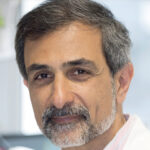Link to Pubmed [PMID] – 15386014
Nature 2004 Sep; 431(7007): 466-71
In vertebrates, skeletal muscle is a model for the acquisition of cell fate from stem cells. Two determination factors of the basic helix-loop-helix myogenic regulatory factor (MRF) family, Myf5 and Myod, are thought to direct this transition because double-mutant mice totally lack skeletal muscle fibres and myoblasts. In the absence of these factors, progenitor cells remain multipotent and can change their fate. Gene targeting studies have revealed hierarchical relationships between these and the other MRF genes, Mrf4 and myogenin, where the latter are regarded as differentiation genes. Here we show, using an allelic series of three Myf5 mutants that differentially affect the expression of the genetically linked Mrf4 gene, that skeletal muscle is present in the new Myf5:Myod double-null mice only when Mrf4 expression is not compromised. This finding contradicts the widely held view that myogenic identity is conferred solely by Myf5 and Myod, and identifies Mrf4 as a determination gene. We revise the epistatic relationship of the MRFs, in which both Myf5 and Mrf4 act upstream of Myod to direct embryonic multipotent cells into the myogenic lineage.




